Every year at about this time I make the same joke at least once. It is a tongue-in-cheek critique of fake Christmas trees as an ethically superior substitute for the real thing. “It’s the only ritual sacrifice we have left!” I whine. “Please let us keep it.”
It is only mostly a joke. I am, in fact, somewhat sensitive to the odd visage of all of us self-described “civilized” folk merrily hanging baubles on the corpse of some evergreen or other, enhancing its form with a string of lights and sitting its stump end in water to keep the tissues from desiccating too quickly. It reminds me of funerals I’ve been at where the funeral director’s make-up artist did their work a little over-zealously if you ask me, but where other attendees keep commenting on how “good” and “natural” the deceased looks. Gives me the willies.
Anyhow, most of us are unaware of the long history of indigenous European seasonal ritual we are echoing by this practice of tree sacrifice. Me included. It’s just something we do. It wouldn’t be the holidays without it! Certainly December is a good month to write about ritual. At our home, at least, it seems we can’t get through a day of this month without some family custom coming due that reminds us of where we are in the year.
So far this essay may seem rather off topic for a writing series focused on mutual ownership between place and people, and its relevance to a truly sustainable agri-culture. Let’s look into the Christmas tree ritual at Tangly Woods in a more complete way and see if I can start to make my point:
We are in Virginia. As the scientific name implies, Juniperus Virginianus (Eastern Red Cedar) is fully endemic here. Surely most folks who aren’t already familiar with the species as “that danged cedar” (so called because of its impressive and panic-inspiring habit of happily volunteering its inedible self in droves in every cattle pasture in this valley) has at some point wondered what all those Christmas tree shaped evergreens are doing growing in every unattended roadside open space. I would also venture that most country folk around here have, at some point, tried making a Christmas tree out of one. For many, their first try is their last, as the warm ritual of hanging ornaments and stringing lights is tarnished by complaints about knuckles getting prickled.
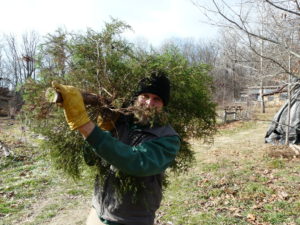
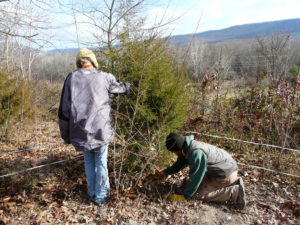 Like everyone else, we have our share of Red Cedars. We differ from the mainstream, though, in that we are just stubborn enough to have adopted them as our standard yuletide sacrifice. Why, we reasoned, should we pay money to have someone else grow a tree for us that must be planted, shaped, sprayed, mowed around, and marketed, when we already have excess trees of the appropriate shape and size whose only fault for ceremonial purposes is their texture? If we just take a little care when decorating, it can work fine. By now, of course, our kids might stage a coup if we proposed anything else…it’s a tradition! Everyone looks forward to the ritual of meandering around our six acres—with a pruning saw in the pocket of yours truly—discussing the merits and demerits of each of the Red Cedars I’ve had my eye on throughout the year which are growing in inconvenient places and are of acceptable height. At length the negotiations are all settled, and I kneel in front of the chosen juniper, fold out the saw blade, tighten the nut, then reach in under the greenery and make my cut. “Timber!” I usually quip as the cedar sapling gently falls onto its bushy side. The trees with their scrawny young trunks are light enough to carry, so we make our way back to the house quickly enough, and I and maybe a helper or two get out a hammer and apply the Christmas tree stand to the tree’s base while others break out the box of Christmas decorations. Then the moment arrives: I carry the tree through the door and position it in its customary spot in our front room next to the piano. Someone puts on Christmas music and everyone falls to; soon the house looks, sounds, and (thanks to the fresh juniper) smells like Christmas.
Like everyone else, we have our share of Red Cedars. We differ from the mainstream, though, in that we are just stubborn enough to have adopted them as our standard yuletide sacrifice. Why, we reasoned, should we pay money to have someone else grow a tree for us that must be planted, shaped, sprayed, mowed around, and marketed, when we already have excess trees of the appropriate shape and size whose only fault for ceremonial purposes is their texture? If we just take a little care when decorating, it can work fine. By now, of course, our kids might stage a coup if we proposed anything else…it’s a tradition! Everyone looks forward to the ritual of meandering around our six acres—with a pruning saw in the pocket of yours truly—discussing the merits and demerits of each of the Red Cedars I’ve had my eye on throughout the year which are growing in inconvenient places and are of acceptable height. At length the negotiations are all settled, and I kneel in front of the chosen juniper, fold out the saw blade, tighten the nut, then reach in under the greenery and make my cut. “Timber!” I usually quip as the cedar sapling gently falls onto its bushy side. The trees with their scrawny young trunks are light enough to carry, so we make our way back to the house quickly enough, and I and maybe a helper or two get out a hammer and apply the Christmas tree stand to the tree’s base while others break out the box of Christmas decorations. Then the moment arrives: I carry the tree through the door and position it in its customary spot in our front room next to the piano. Someone puts on Christmas music and everyone falls to; soon the house looks, sounds, and (thanks to the fresh juniper) smells like Christmas.
Am I contending that our way of doing the Christmas tree thing is bioregionally specific? No, I am actually not. It only illustrates some of the process of the development of customs in a place; as it happens the particulars are not very unique to our bioregion. Beyond the fact that for us it wouldn’t hold half the meaning if the tree didn’t come from this piece of land that we love, this same story could just as easily happen anywhere across the temperate eastern half of this continent (or wherever else Juniperus Virginianus is to be found), varying only perhaps by the typical weather conditions at the time of the cutting. However, residents of the Canaan Valley in West Virginia and its surrounds have a variant that is unusual: The Canaan Valley National Wildlife Refuge has a program of reducing its population of exotic Scotch Pine. Those trees cut out of the refuge before Christmas time are left near the headquarters for any area residents to retrieve for free and use as Christmas trees. My in-laws (who live most of the time in that vicinity) took advantage of this and brought a cute little example with them last time they came over. It is now lending its charm to the center of the train set board (the old Lionel set is another Myers holiday tradition) in the common room upstairs.
The rituals I see materializing here among us on our home place springing from the way we are trying to live suggest to me that the bioregionally specific assemblage of products and processes that will necessarily characterize the sustainable agriculture of each place will, in due course and combined with the inevitably closer relationship to seasonal cycles and changes, produce a great number of characteristic ritual activities in the lives of the folk who belong to each place. Some of these may be simple and utilitarian (at least at first), but to the practitioners the effect may still be comforting and familiar. Mulching carrots, for example:
We can’t grow spring carrots. Sorry, it’s just bad luck. There is a bug that is active in our area in spring that burrows around in the surface of the carrots’ tap root, rendering the plants unhealthy and stressed, which makes any carrot material that the bugs leave us high in terpenes; too sharp in flavor to enjoy. In fall, however, carrots sown early enough (we missed it this year, darn it) often produce well and those bugs have calmed down enough to let the plants fill out sweet, crunchy taproots. We have found that if we mulch the carrots deeply in December the mulch will protect the roots from hard freeze damage and we can dig them much of the winter (though the sweetness declines over time as the plants are starved of sunlight). So after we have raked and carted home our neighbors’ leaves (It wouldn’t be fall without that!), they are sitting in a heap waiting when the weather threatens a night cold enough to make us worry about our carrot crop. With a strong nip in the air, I found myself again this December wheeling loads of leaves to the carrot beds, shaking handfuls of them over the sprightly green tops, trusting the crop to the earth’s warmth, hoping the voles don’t help themselves to too many! Give me another few years of that, and I may have some sacred words to chant while I spread.
And there are other rituals emerging here at Tangly Woods. Remember those Christmas tree corpses? Well, when they are too desiccated to be fun anymore (juniper needles all over the floor, anyone?), we take that as our cue to put away the Christmas stuff, and the tree goes out the side door to the brush pile. Unlike our urban peers who drag theirs to the curb to be discarded, however, we aren’t done with it yet! Its boughs will be trimmed off and will live in the brush pile for almost a year, with all the prunings and slashings from a year’s farm work steadily accumulating on top of them (the trunk may become a garden corner marker). At the winter solstice, they will be burned.
But not burned up! They will be burned to char along with all the other assembled brush in a hand-dug pit, and our year’s composting will occur on top of the accumulated char; the effluent from the compost will soak the char with nutrients, the combination yielding a fertility-enhancing, humus-building soil conditioner known as biochar. The distribution of this life-giving soil amendment rendered from so much death and decay and combustion is likely to become a meaningful ritual of its own in our lives, but as yet it is too young a tradition (this spring will be our second year to apply biochar) to characterize it, let alone write the litany for it (though I did write a meditation before last year’s burn: http://myers-benner.blogspot.com/2016/12/winter-carbon-party-we-kindle-this-fire.html)! The burning of the char has become a special yearly event, and we’ve started to hold solstice gatherings on that day, tying into the old bonfire tradition.
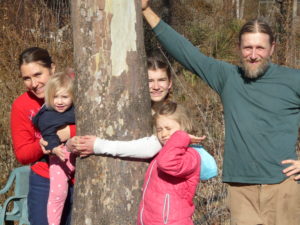
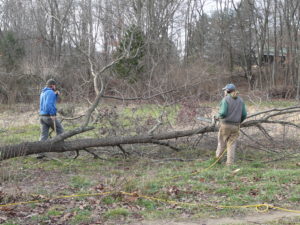
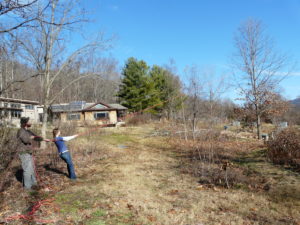 Late fall and winter is also the time for cutting trees for timber and firewood, as the leaves are off the deciduous trees and the wood is at its least sappy. Cutting and cleaning up trees is a yearly ritual we are right in the middle of right now, in fact. As the giant plants thundered to the ground yesterday, I wished I had words to hold my grief over their loss. This year’s taking was especially difficult…some of these were trees we had liked very hard. But their roots were threatening our gardens and septic system, some of their branches threatened to fall on our poultry coops or garden shed. We had to be the judges, and in our judgment it was time. Not knowing what else to do to mark the moment, we took our pictures with them before they fell. We’ll use the wood to build some special projects, including our oldest daughter’s favorite climbing tree becoming her new bunk bed and ladder hung from the ceiling in the girls’ room.
Late fall and winter is also the time for cutting trees for timber and firewood, as the leaves are off the deciduous trees and the wood is at its least sappy. Cutting and cleaning up trees is a yearly ritual we are right in the middle of right now, in fact. As the giant plants thundered to the ground yesterday, I wished I had words to hold my grief over their loss. This year’s taking was especially difficult…some of these were trees we had liked very hard. But their roots were threatening our gardens and septic system, some of their branches threatened to fall on our poultry coops or garden shed. We had to be the judges, and in our judgment it was time. Not knowing what else to do to mark the moment, we took our pictures with them before they fell. We’ll use the wood to build some special projects, including our oldest daughter’s favorite climbing tree becoming her new bunk bed and ladder hung from the ceiling in the girls’ room.
Some actions spawn a cascade of other yearly jobs that take on their own meaning. Taking down trees means firewood processing and brush hauling, sometimes lugging saw logs to town for milling. One of my favorite rituals of the year is—once we’ve burned through or discarded the remaining wood from one side of our wood shed—refilling that side with seasoned wood from the roofless stack assembled the previous winter at tree felling time. I, and sometimes a helper or two, wheel barrows full of wood to the mouth of the shed where the small rounds are stacked as is and the bigger pieces are reduced to usable size with a splitting maul and some carefully focused swinging of the arms. With our passive solar, earth banked, super-insulated home we burn so little wood that it only takes a day or so to work through and stack the necessary amount. Part of what makes it enjoyable is that I don’t get to do quite as much of it as I would like!
But by far the most common rituals around here center on harvests, preservation, and other food-centric events, such as the annual spate of taste-testing of popcorn and squashes for breeding purposes. The smaller annual food tasks and practices come around so frequently I suspect eventually the year will feel like one long, elaborate ritual that we modify slightly based on what we learned the year before. Some events stand out from the others, though. In particular, food events like cider pressing that require or at least beg the presence of a group of folks instead of just one or two practitioners are the ones that hold extra meaning.
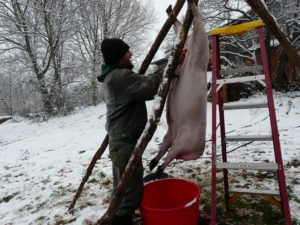 Hog butchering exemplifies this, and in fact may be the finest example I know of a ritual that is common over much of the world but whose timing, elements, character, sequence, and products are influenced by the place in which it occurs, and by the people who have called that place home.
Hog butchering exemplifies this, and in fact may be the finest example I know of a ritual that is common over much of the world but whose timing, elements, character, sequence, and products are influenced by the place in which it occurs, and by the people who have called that place home.
We are new to this ritual, but for the self-provisioning rural folks of many, many places in the world, hog butchering is a familiar, cherished, scripted, annually repeating celebration of relationships with other humans and with the natural world. The wonderfully omnivorous hogs have been making their way through the scraps and forages and surplus of the year’s productivity, assembling all of it into a most highly edible and delicious package of foods that is their body, and when the weather starts to turn cold in fall, when the gardens and pastures and forests have finished their seasonal flush and are going dormant, the time arrives to harvest their bounty.
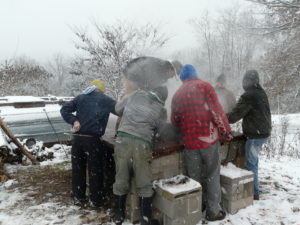 It is a big job, and not one you want to tackle without help and guidance. Generations of hog utilization by folks who regard each morsel as precious have resulted in time-tested methods and equipment; the newbie does well to appreciate both. Immigrants to this country brought their own culture’s developed preferences with them; some of the local hog butchering traditions we find in different regions today owe a lot to which ethnic group happened to predominate among the settlers of the region. Let’s try a possible example.
It is a big job, and not one you want to tackle without help and guidance. Generations of hog utilization by folks who regard each morsel as precious have resulted in time-tested methods and equipment; the newbie does well to appreciate both. Immigrants to this country brought their own culture’s developed preferences with them; some of the local hog butchering traditions we find in different regions today owe a lot to which ethnic group happened to predominate among the settlers of the region. Let’s try a possible example.
In Virginia, bones, meat scraps and some organ meats were traditionally cooked together to make a rich broth, sometimes with the cooked meat bits ground (also known as Puddin’ Meat) and returned to it, which was then combined with flour and cornmeal and spiced. Poured into loaf pans and allowed to set, then fried in slices as a breakfast food, this is known as Ponhoss, sometimes given a more Germanic spelling, Pan Haus or Paun Haus (I’ve seen several spellings). Indeed, this food supposedly has German roots, maybe by way of Pennsylvania, where a very similar food is the beloved Scrapple. Each part of Virginia (and some other places across the South), including areas with little Germanic heritage, now has its own tradition regarding this food, and many families will have their own recipe. I imagine, however, that in the Germany the first immigrants came out of, American Corn (“Maize”, “Indian Corn”) would not have been included, being non-native and unknown. Here, corn has always been the easiest staple to grow to practically provide for a family on the land…around here ponhoss without cornmeal isn’t ponhoss, I’ll warrant. For our purposes, we—like nearly all other American homesteaders through history—have found that wheat is hard for us to produce in quantity for our own use in small gardens, whereas corn is easier. Last year was our first hog butchering, and, determined to use what we had (we had no significant amount of wheat flour), we ground up some popcorn we had on hand to polenta-sized grits (we have limited access to fine grinding) and made our ponhoss with that. “It was different” one of the more experienced friends who helped us butcher said of the result. “A little chewy, but good.” This year we had enough of our own flint corn to use. We got the grits a little finer and the seed coat was less course. Based on how fast the bowls of fresh ponhoss were emptied by the kids around the kettle on butchering day, I would say it worked! A new tradition? It is likely to be in our house…who knows if it will catch on in the neighborhood?
For many individuals who came up in subsistence or partial-subsistence agriculture traditions, a certain look seems to come into their eye or a certain tone creeps into their writing when they relate the details of hog butchering. And it does seem to be the details that stick: the grandmother who would inflate the freshly cleaned intestines to check for holes before stuffing the sausage, the uncle who was the best at retrieving every usable scrap from the heads, the taste of that fresh liver. Do you prefer your cracklins with rind on or off? Is head cheese a savory delight or will it ruin your appetite? Will you spread a little salt on a succulent piece of tongue pulled out of the ponhoss kettle and close your eyes in rapt enjoyment, or are you not there yet? Is acorn-fattened hog the prize you seek, or do you believe acorns lend a strong flavor to the meat? Do you shoot the pig in the head before sticking it or is the brain too valuable as food? The preferences that develop over all these sorts of factors may point to random chance and may be contributed by folks who brought traditional elements with them, but if we look at the traditions that have emerged among groups of people ecologically connected to a place over time, I am sure we will see many elements that are a direct reflection of the forces and resources at work and available there. What foods did the hog feed on, and how does that develop the flavor and texture of different cuts of meat, and therefore usage? How long is the growing season, and how does that play into the age of the hogs at butchering time? What is the typical weather at butchering time, and how does that enable or inhibit various fermentation and curing processes? Has proximity to industrial centers permitted affordable acquisition of technologies to aid in more complex or precise processing? How relatively expensive has bulk salt been? Other spices? Have people been coming and going frequently, or have generations of a family lived in the same spot, accumulating tools, lore, and knowhow?
At this point I had better clear something up: I do intend this essay to be specifically about rituals, as opposed to traditions, clearly related though the two are. It’s also not about habits or seasonally prescribed tasks per se. I am not an expert on ritual, but my take on it is that ritual differs from these other concepts in that it is a set or sequence of prescribed actions that are associated with a given activity and assist the doer(s) in doing it in a way that is regarded as proper or dutiful. It assists the doer(s) by: a) being a memory aid, b) preventing the need to reinvent the process every time, c) encouraging some degree of skill specialization, and/or d) giving a context for emotional expression and stability at significant passages. Goodness knows in the week leading up to and including the day of killing pigs (or even more, for me, for the felling of a favorite tree), I could use some assistance with the emotional work involved. It gets complicated. Some wisdom in the form of ceremony would help, I think.
Rituals for all sorts of purposes are one of the hallmarks of a developed culture. If we don’t have well-developed rituals for our lives from the culture of our birth, then I’ll assert we’ll be adrift or casting about for them until we find something that works for us or is a usable substitute. I think ritual is something we are adapted to; it is one of our instinctual ways of coping, as intelligent beings open to the complexity of a world we are capable of inhabiting in nearly all its myriad permutations. So when a group of us settles down to one of those permutations, one of the things we are naturally going to do, I argue, is to set to work establishing a set of rituals to guide and comfort us. They are the way one generation says to the next, “Here’s what worked for us. Do this and you’ve got a decent shot at making it here.”
Dave Jacke—one of my permaculture teachers—said something like, “Look, we’re all designing all the time…we might as well get good at it.” When it comes to rituals, I’ll argue that same point. Most of us are the products of the most discombobulated, most exploded mass culture the world has seen. As those shattered cultural pieces settle into new arrangements, partially taking the shape of any of the places where they must do that, surely each group in each place will end up with a set of rituals, as our species has done since time beyond memory. As I have argued other places in this year’s writing series, if we take our opportunity to start the re-settling process consciously and before it’s a dire, present emergency of survival, we may save a lot of suffering for our descendants or even our own selves. It is clear to me that consciously working to establish useful rituals is a key part of this, and stands a chance of bringing some much needed stability and comfort into our lives in the bargain.
